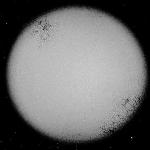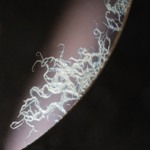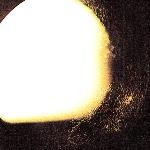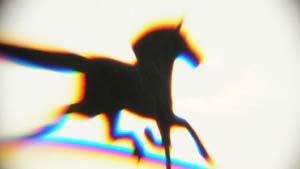A Short Used Binocular Checklist
MenuWhen do you need a used binocular checklist? Whenever you're holding a used binocular in your hands and wondering if it's worth the price being asked!
When you're at an estate sale, car boot sale/flea market, pawn shop, a plain old "junk" shop, or some other place and you find a binocular that you think might be worth more than the asking price, you need to:
-
 Hold the potential binocular at arm's length and
look at the exit pupils. Are they perfectly round or are
they flattened on one or more sides? If there is flattening,
often called vignetting, it means the prisms are made of
low-cost glass and light is bouncing off the sides of the
prisms and affecting the entire optical system. The other
potential reason for flattening is less common, but the
interior elements may be slightly misaligned. Either way,
you're in for eye fatigue if you use them as much as you want
to and should. Passing this test is critical. In other words,
if the binocular does not pass this test it's not worth spending
further time with it. Count yourself lucky to have had your
used binocular checklist either on-hand or in mind!
Hold the potential binocular at arm's length and
look at the exit pupils. Are they perfectly round or are
they flattened on one or more sides? If there is flattening,
often called vignetting, it means the prisms are made of
low-cost glass and light is bouncing off the sides of the
prisms and affecting the entire optical system. The other
potential reason for flattening is less common, but the
interior elements may be slightly misaligned. Either way,
you're in for eye fatigue if you use them as much as you want
to and should. Passing this test is critical. In other words,
if the binocular does not pass this test it's not worth spending
further time with it. Count yourself lucky to have had your
used binocular checklist either on-hand or in mind!
- Focus the binocular using the diopter adjustment. You'll want a diopter that stays put once it's adjusted. If it locks or otherwise keeps its setting, it's alright. If it doesn't keep its setting, you'll spend more time re-adjusting the diopter than the binocular is worth. Passing this test is essential. (Hurrah for your used binocular checklist!) If it's an auto-focus binocular, you'll want to ensure that you've reviewed your understanding of that type of binocular ahead of time
- When the binocular is focused, look through it for a few long seconds to see if your eyes feel a bit of "pull" in them. If the binocular is well focused, odds are that the pull is caused by the binocular out of collimation (the barrels are not aligned properly). To check the collimation, focus on a distant object (at least 100 yards/meters away) and close first one eye and then the other. If the image "jumps" up/down or seems to rotate noticeably between eyes there is a problem with the vertical or rotational collimation, respectively. To check the horizontal collimation, look at a vertical straight line such as the edge of a building or tall pole and, alternating eyes again, see if the vertical line moves appreciably to the left/right when you alternate eyes. Our eyes naturally converge or cross slightly to enable us to focus on objects and binoculars typically have a slight "crossing" to them for this purpose - so the left/right movement should be more than just a tiny amount. Passing this test is critical. Put the binocular down and walk away if it doesn't pass! (You're still singing praises for your used binocular checklist, right?!? It just saved you from nasty headaches!)
- You'll want a waterproof and fog-proof binocular unless you live in an arid region, but that's a little difficult to test with many used binocular sellers. A rough alternative is to look inside through the objective lenses and see if there appears to be dust or the effects of humidity inside the barrels. Having a lens brush along to ensure that you're not seeing dust on the lenses can help in some situations. Because binoculars have moving parts, even the best will lose their waterproofing seals over a period of years, but you don't want them to be letting dust and dirt inside the instrument unless you're purchasing a "vintage instrument." If the binocular is to serve strictly ornamental purposes.... We'll leave it up to you as to whether or not this is a critical test.
- While looking inside through the objective lenses, you'll want to be alert to fungal growth which can sometimes be rather fine and difficult to see. Look for this while you're shining a light through the objective lenses - especially checking around the outside edges of the objectives and looking through to the eyepiece lenses. If we see strange growths on the interior of the barrels, but not on glass, we expect that it's only a matter of time before the glass is affected and we abandon a prospective purchase on that basis. If you can already see fungus growing on a lens or the view is troublesome, remember that a fungus doesn't stop growing until it's cleaned out of the instrument.
- Examine the various mechanical elements of the instrument to ensure they work appropriately. You already know about the diopter adjustment, so turn your attention to the hinge, the central or individual focus mechanism(s), and the eyecups. Each should have smooth action and work without sticking or being unusually "hard." The hinge should have a smooth action and steady resistance as you flex it. The eyecups should allow you to see well if you will be wearing eyeglasses and this means checking your comfort with the amount of eye relief provided while examining the eyecups. Rubber eyecups that fold down to use with eyeglasses tend to deteriorate over time and this has resulted in twist-up eyecups being adopted in many better quality binoculars made with the expectation of years of use.
- To check the brightness and crispness/sharpness of the optics, look into the areas around you with the least amount of light. Looking outdoors through a window or door, while almost instinctive, will naturally give a brighter image and give you a potentially false sense of the optics' capabilities. You want a bright image under low light conditions. Especially look for fine details or written/printed things in dimly lit areas and try to read them clearly to see how crisp/sharp the image is. This test is best if you're able to hold a binocular of known quality above/below the one you're considering and quickly and smoothly shift your view between them while looking at license plates, dark corners, or peering into underbrush. This test will necessarily be a bit subjective, but the more shopping experience you get and the more good quality optics you have looked through, the better your judgment will be. This test, in conjunction with looking through the objective lenses into the barrels, should help to reveal fungal growth on the prisms or elsewhere since your view will potentially be affected. (This small tip alone will enhance your pre-purchase review routine handsomely. Pretty good used binocular checklist?)
- You may want to remember that phase coating in roof prism design binoculars was popularized in the late 1980s. Prior to phase coating, the Porro prism design was optically superior to the roof prism design. Also, widespread use of fully multi-coated optics didn't occur until after the 1980s had passed. This information may influence your choice if you're able to determine the approximate age of an instrument you're considering.
- Scrutinize the image while looking at things with straight vertical and horizontal lines. You're looking for excessive distortion and you'll want to examine the edges of your field of view in addition to the sweet spot in the center. You'll no doubt remember that slight pincushioning is often engineered into binoculars as a tradeoff to avoid the "rolling ball" or globe effect.
- Look at something against a bright background. Looking at an overhead wire against a bright sky is one option. Looking at a light-colored, distant car, house or bird is another. You're looking for chromatic aberrations that show up as colors typically haloing or showing up on the left/right or bottom/top of the object. These would be likely to distract from your viewing pleasure, if you were to purchase an instrument with distinct aberrations.
- If after looking through the binocular long enough to complete these brief tests your eyes feel at all uncomfortable, you'll likely be better off waiting for the next instrument to come along.
- While using this brief, used binocular checklist won't guarantee your purchase will be delightful (it is YOUR choice, after all!), it will help you make a more informed decisions while scouting for your very own good quality, inexpensive binoculars.
Fungi Growing on Lenses




Home > Finding Cheap Binoculars > Used Binocular Checklist


Your Comments
This site is for you, our readers. We appreciate your comments very much.